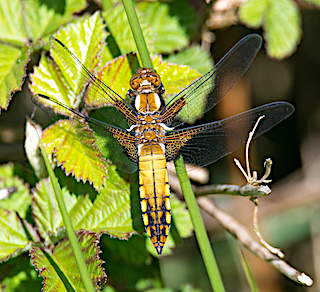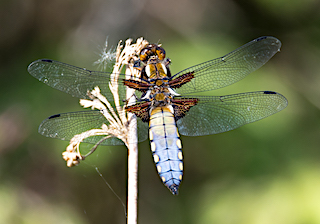 Windmill Farm is a haven for dragon- and damselflies, including species such as this Broad-bodied Chaser.
Windmill Farm is a haven for dragon- and damselflies, including species such as this Broad-bodied Chaser.
Photo: Dougy Wright
Scientific name: Libellula depressa
Other common names: Broad-bodied Darter
Conservation status: IUCN Red List: Least Concern
What to look for:
• Colouring: The broad, flattened abdomen is pale blue in adult males, brown in immature males, and golden-brown in females, with yellow spots along the side in both sexes. The wing bases are dark brown, and the eyes are a chocolate brown.
• Size: Up to 4 cm in length, with a wingspan of up to 7 cm.
• Where: Flies from May to August (and sometimes in April and September) across the southern England and Wales. It breeds in ponds, and can be spotted perching on vegetation or darting as it hunts its prey.
• Similar species: Females could be confused with the Four-spotted Chaser, but lack the dark spot halfway along the edge of each of the wings.
 As the weather warms in the summer, a walk by freshwater will be an unusual one if you don’t spot any dragonflies. If you are walking alongside a pond or small lake, then you should watch out for the distinctive-looking Broad-bodied Chaser, with its flattened, fat-looking body and darting flight. On the wing between May and August, this dragonfly is widespread across southern England and Wales, this dragonfly has a range that extends across Europe and central Asia. Adult males have a powder-blue body, but the females are a honey-brown colour, making it sometimes difficult to tell them apart from its cousin the Four-spotted Chaser, in which both sexes are brown (the latter, however, has a distinctive dark spot halfway along each of its four wings – hence its common name).
As the weather warms in the summer, a walk by freshwater will be an unusual one if you don’t spot any dragonflies. If you are walking alongside a pond or small lake, then you should watch out for the distinctive-looking Broad-bodied Chaser, with its flattened, fat-looking body and darting flight. On the wing between May and August, this dragonfly is widespread across southern England and Wales, this dragonfly has a range that extends across Europe and central Asia. Adult males have a powder-blue body, but the females are a honey-brown colour, making it sometimes difficult to tell them apart from its cousin the Four-spotted Chaser, in which both sexes are brown (the latter, however, has a distinctive dark spot halfway along each of its four wings – hence its common name).
 The males defend their territory aggressively against intruders, and can be spotted patrolling up and down as they hunt for food, or perching amongst the vegetation, often favouring the same spot. Males and females mate in flight during the summer, remaining in tandem very briefly. The female then drops her fertilised eggs into the water as she hovers, flicking her abdomen into the water. The larvae, like all dragonfly nymphs, are active predators, ambushing prey from amongst the mud and plants at the bottom of the waterbody for about two years, before climbing up vegetation to complete their emergence as a fully-winged adult.
The males defend their territory aggressively against intruders, and can be spotted patrolling up and down as they hunt for food, or perching amongst the vegetation, often favouring the same spot. Males and females mate in flight during the summer, remaining in tandem very briefly. The female then drops her fertilised eggs into the water as she hovers, flicking her abdomen into the water. The larvae, like all dragonfly nymphs, are active predators, ambushing prey from amongst the mud and plants at the bottom of the waterbody for about two years, before climbing up vegetation to complete their emergence as a fully-winged adult.
Did you know…?
…Dragonflies do not go through a pupal stage in their development, unlike butterflies. The adult emerges from the final moult of the larval stage, which takes place above the waterbody surface. The website of the British Dragonfly Society https://british-dragonflies.org.uk has lots of information about the biology and ecology of dragonflies.
…If themselves threatened by a predator, the larvae will sometimes pretend to be dead to avoid capture
Published: May 2018
Author: Amanda Scott
Photos: Dougy Wright (upper photo of female, and middle photo of male; Ray Surridge, lower photo of male)
